Preparation of Monoclonal Antibody and Development of Indirect Competitive Enzyme-Linked Immunosorbent Assay and Fluorescence-Linked Immunosorbent Assay for Detecting 3-Amino-5-methylmorpholino-2-oxazolidinone (AMOZ) in Edible Animal Tissue
Abstract
1. Introduction
2. Materials and Methods
2.1. Materials and Reagents
2.2. Preparation of AMOZ-Protein Conjugate
2.3. Production of mAb by Hybridoma Approach
2.4. Procedure of ic-ELISA
2.5. Procedure of FLISA
2.6. Determination of Cross-Reactivity
2.7. Samples Preparation
2.8. Validation of the ic-ELISA and FLISA Method
3. Results and Discussion
3.1. Design and Synthesis of Haptens
3.2. Screening of Monoclonal Antibodies
3.3. Standard Curve and Cross-Reactivity for the ic-ELISA and FLISA
3.4. Validation of the ic-ELISA and FLISA
3.5. Comparison of Published Detection Methods for AMOZ or 2-NP-AMOZ
4. Conclusions
Author Contributions
Funding
Institutional Review Board Statement
Informed Consent Statement
Data Availability Statement
Conflicts of Interest
Sample Availability
References
- Radovnikovic, A.; Moloney, M.; Byrne, P.; Danaher, M. Detection of banned nitrofuran metabolites in animal plasma samples using UHPLC–MS/MS. J. Chromatogr. B 2011, 879, 159–166. [Google Scholar] [CrossRef] [PubMed]
- Le, T.; Xie, Y.; Zhu, L.Q.; Zhang, L. Rapid and sensitive detection of 3-amino-2-oxazolidinone using a quantum dot-based immunochromatographic fluorescent biosensor. J. Agric. Food Chem. 2016, 64, 8678–8683. [Google Scholar] [CrossRef] [PubMed]
- Shen, Y.D.; Xu, Z.L.; Zhang, S.W.; Wang, H.; Yang, J.Y.; Lei, H.T.; Xiao, Z.L.; Sun, Y.M. Development of a monoclonal antibody-based competitive indirect enzyme-linked immunosorbent assay for furaltadone metabolite AMOZ in fish and shrimp samples. J. Agric. Food Chem. 2012, 60, 10991–10997. [Google Scholar] [CrossRef]
- Shen, J.; Zhang, Z.; Yao, Y.; Shi, W.; Liu, Y.; Zhang, S. A monoclonal antibody-based time-resolved fluoroimmunoassay for chloramphenicol in shrimp and chicken muscle. Anal. Chim. Acta 2006, 575, 262–266. [Google Scholar] [CrossRef]
- Xie, Y.; Zhang, L.; Le, T. An immunochromatography test strip for rapid, quantitative and sensitive detection of furazolidone metabolite, 3-amino-2-oxazolidinone, in animal tissues. Food Agric. Immunol. 2017, 28, 403–413. [Google Scholar] [CrossRef]
- Cooper, K.M.; Mulder, P.P.J.; van Rhijn, J.A.; Kovacsics, L.; McCracken, R.J.; Young, P.B.; Kennedy, D.G. Depletion of four nitrofuran antibiotics and their tissue-bound metabolites in porcine tissues and determination using LC-MS/MS and HPLC-UV. Food Addit. Contam. 2005, 22, 406–414. [Google Scholar] [CrossRef]
- Pimpitak, U.; Putong, S.; Komolpis, K.; Petsom, A.; Palaga, T. Development of a monoclonal antibody-based enzyme-linked immunosorbent assay for detection of the furaltadone metabolite, AMOZ, in fortified shrimp samples. Food Chem. 2009, 116, 785–791. [Google Scholar] [CrossRef]
- Liu, Y.C.; Jiang, W.; Chen, Y.J.; Xiao, Y.; Shi, J.L.; Qiao, Y.B.; Zhang, H.J.; Li, T.; Wang, Q. A novel chemiluminescent ELISA for detecting furaltadone metabolite, 3-amino-5-morpholinomethyl-2-oxazolidone (AMOZ) in fish, egg, honey and shrimp samples. J. Immunol. Methods 2013, 395, 29–36. [Google Scholar] [CrossRef] [PubMed]
- Le, T.; Yu, H. Determination of 3-amino-2-oxazolidinone in animal tissue by an enzyme-linked immunosorbent assay and a time-resolved fluoroimmunoassay. Anal. Lett. 2015, 48, 1275–1284. [Google Scholar] [CrossRef]
- Le, T.; Zhang, Z.; Wu, J.; Shi, H.; Cao, X. A fluorescent immunochromatographic strip test using a quantum dot-antibody probe for rapid and quantitative detection of 1-aminohydantoin in edible animal tissues. Anal. Bioanal Chem. 2018, 410, 565–572. [Google Scholar] [CrossRef] [PubMed]
- Sun, Q.; Luo, J.; Zhang, L.; Zhang, Z.; Le, T. Development of monoclonal antibody-based ultrasensitive enzyme-linked immunosorbent assay and fluorescence-linked immunosorbent assay for 1-aminohydantoin detection in aquatic animals. J. Pharm. Biomed. Anal. 2018, 147, 417–424. [Google Scholar] [CrossRef] [PubMed]
- Barbosa, J.; Moura, S.; Barbosa, R.; Ramos, F.; da Silveira, M.I. Determination of nitrofurans in animal feeds by liquid chromatography-UV photodiode array detection and liquid chromatography-ionspray tandem mass spectrometry. Anal. Chim. Acta 2007, 586, 359–365. [Google Scholar] [CrossRef] [PubMed]
- Zhang, Y.; Qiao, H.; Chen, C.; Wang, Z.; Xia, X. Determination of nitrofurans metabolites residues in aquatic products by ultra-performance liquid chromatography-tandem mass spectrometry. Food Chem. 2016, 192, 612–617. [Google Scholar] [CrossRef] [PubMed]
- Wilasinee, D.; Sutthivaiyakit, P.; Sutthivaiyakit, S. Determination of nitrofurans in chicken feed by high-performance liquid chromatography–tandem mass spectrometry. Anal. Lett. 2015, 48, 239–248. [Google Scholar] [CrossRef]
- Valera-Tarifa, N.M.; Plaza-Bolaños, P.; Romero-González, R.; Martínez-Vidal, J.L.; Garrido-Frenich, A. Determination of nitrofuran metabolites in seafood by ultrahigh performance liquid chromatography coupled to triple quadrupole tandem mass spectrometry. J. Food Compos. Anal. 2013, 30, 86–93. [Google Scholar] [CrossRef]
- Kim, D.; Kim, B.; Hyung, S.W.; Lee, C.H.; Kim, J. An optimized method for the accurate determination of nitrofurans in chicken meat using isotope dilution–liquid chromatography/mass spectrometry. J. Food Compos. Anal. 2015, 40, 24–31. [Google Scholar] [CrossRef]
- Aldeek, F.; Hsieh, K.C.; Ugochukwu, O.N.; Gerard, G.; Hammack, W. Accurate Quantitation and Analysis of Nitrofuran Metabolites, Chloramphenicol, and Florfenicol in Seafood by Ultrahigh-Performance Liquid Chromatography-Tandem Mass Spectrometry: Method Validation and Regulatory Samples. J. Agric. Food Chem. 2018, 66, 5018–5030. [Google Scholar] [CrossRef]
- Li, M.X.; Yang, H.; Li, S.Q.; Liu, C.W.; Zhao, K.; Li, J.G.; Jiang, D.N.; Sun, L.L.; Wang, H.; Deng, A.P. An ultrasensitive competitive immunochromatographic assay (ICA) based on surface-enhanced Raman scattering (SERS) for direct detection of 3-amino-5-methylmorpholino-2-oxazolidinone (AMOZ) in tissue and urine samples. Sens. Actuators B Chem. 2015, 211, 551–558. [Google Scholar] [CrossRef]
- Li, S.; Song, J.; Yang, H.; Cao, B.; Chang, H.; Deng, A. An immunochromatographic assay for rapid and direct detection of 3-amino-5-morpholino-2-oxazolidone (AMOZ) in meat and feed samples. J. Sci. Food Agric. 2014, 94, 760–767. [Google Scholar] [CrossRef]
- Song, J.; Yang, H.; Wang, Y.; Si, W.; Deng, A. Direct detection of 3-amino-5-methylmorpholino-2-oxazolidinone (AMOZ) in food samples without derivatisation step by a sensitive and specific monoclonal antibody based ELISA. Food Chem. 2012, 135, 1330–1336. [Google Scholar] [CrossRef]
- Luo, P.J.; Jiang, W.X.; Beier, R.C.; Shen, J.Z.; Jiang, H.Y.; Miao, H.; Zhao, Y.F.; Chen, X.; Wu, Y.N. Development of an enzyme-linked immunosorbent assay for determination of the furaltadone etabolite, 3-amino-5-morpholinomethyl-2-oxazolidinone (AMOZ) in animal tissues. Biomed. Environ. Sci. 2012, 25, 449–457. [Google Scholar]
- Xu, Z.L.; Shen, Y.D.; Sun, Y.M.; Campbell, K.; Tian, Y.X.; Zhang, S.W.; Lei, H.T.; Jiang, Y.M. Novel hapten synthesis for antibody production and development of an enzyme-linked immunosorbent assay for determination of furaltadone metabolite 3-amino-5-morpholinomethyl-2-oxazolidinone (AMOZ). Talanta 2013, 103, 306–313. [Google Scholar] [CrossRef] [PubMed]
- Xu, Z.L.; Zhang, S.W.; Sun, Y.M.; Shen, Y.D.; Lei, H.T.; Jiang, Y.M.; Eremin, S.A.; Yang, J.Y.; Wang, H. Monoclonal antibody-based fluorescence polarization immunoassay for high throughput screening of furaltadone and its metabolite AMOZ in animal feeds and tissues. Comb. Chem. High Throughput Screen. 2013, 16, 494–502. [Google Scholar] [CrossRef] [PubMed]
- Deng, L.H.; Dai, J.B.; Xu, Z.L.; Yang, J.Y.; Wang, H.; Xiao, Z.L.; Lei, H.T.; Sun, Y.M.; Shen, Y.D. Application of time-resolved fluroimmunoassay for determination of furaltadone metabolite 3-amino-5-morpholinomethyl-2-oxazolidinone. Chin. J. Anal. Chem. 2016, 44, 1286–1290. [Google Scholar] [CrossRef]
- Liang, Y.; Huang, X.; Yu, R.; Zhou, Y.; Xiong, Y. Fluorescence ELISA for sensitive detection of ochratoxin A based on glucose oxidase-mediated fluorescence quenching of CdTe QDs. Anal. Chim. Acta 2016, 936, 195–201. [Google Scholar] [CrossRef]
- Yang, Q.; Zhu, J.; Ma, F.; Li, P.; Zhang, L.; Zhang, W.; Ding, X.; Zhang, Q. Quantitative determination of major capsaicinoids in serum by ELISA and time-resolved fluorescent immunoassay based on monoclonal antibodies. Biosens. Bioelectron. 2016, 81, 229–235. [Google Scholar] [CrossRef] [PubMed]
- Peng, C.; Li, Z.; Zhu, Y.; Chen, W.; Yuan, Y.; Liu, L.; Li, Q.; Xu, D.; Qiao, R.; Wang, L.; et al. Simultaneous and sensitive determination of multiplex chemical residues based on multicolor quantum dot probes. Biosens. Bioelectron. 2009, 24, 3657–3662. [Google Scholar] [CrossRef] [PubMed]
- Chen, J.; Xu, F.; Jiang, H.; Hou, Y.; Rao, Q.; Guo, P.; Ding, S. A novel quantum dot-based fluoroimmunoassay method for detection of Enrofloxacin residue in chicken muscle tissue. Food Chem. 2009, 113, 1197–1201. [Google Scholar] [CrossRef]
- García-Fernández, J.; Trapiella-Alfonso, L.; Costa-Fernández, J.M.; Pereiro, R.; Sanz-Medel, A. A Quantum Dot-Based Immunoassay for Screening of Tetracyclines in Bovine Muscle. J. Agric. Food Chem. 2014, 62, 1733–1740. [Google Scholar] [CrossRef]
- Le, T.; Zhu, L.; Yang, X. A quantum dot-based immunoassay for screening of tylosin and tilmicosin in edible animal tissues. Food Addit. Contam. A 2015, 32, 719–724. [Google Scholar]
- Xie, Y.; Zhang, L.; Sun, Q.; Zhang, Z.; Le, T. Immunochromatographic Assay for Simultaneous and Quantitative Detection of 3-Methyl-Quinoxaline-2-Carboxylic Acid and Quinoxaline-2-Carboxylic Acid Residues in Animal Tissues Based on Highly Luminescent Quantum Dot Beads. Food Anal. Methods 2017, 11, 334–342. [Google Scholar] [CrossRef]
- Xie, Y.; Zhang, L.; Yang, X.; Le, T. Development of a quantum dot-based immunochromatography test strip for rapid screening of oxytetracycline and 4-epioxytetracycline in edible animal tissues. Food Addit. Contam. A 2017, 34, 371–378. [Google Scholar] [CrossRef] [PubMed]
- EC Commission decision 2003/181/EC 13 March 2003, amending decision 2002/657/EC as regards the setting of minimum performance limits (MRPLs) for certain residues in food animal origin. Off. J. Eur. Community 2003, L71, 17.
- Sheu, S.Y.; Tai, Y.T.; Li, W.R.; Lei, Y.C.; Hsieh, K.H.; Lin, C.Y.; Cheng, C.C.; Chang, T.H.; Kuo, T.F. Development of a competitive ELISA for the detection of a furaltadone marker residue, 3-amino-5-morpholinomethyl-2-oxazolidinone (AMOZ), in cultured fish samples. J. Vet. Med. Sci. 2012, 74, 1439–1446. [Google Scholar] [CrossRef] [PubMed][Green Version]
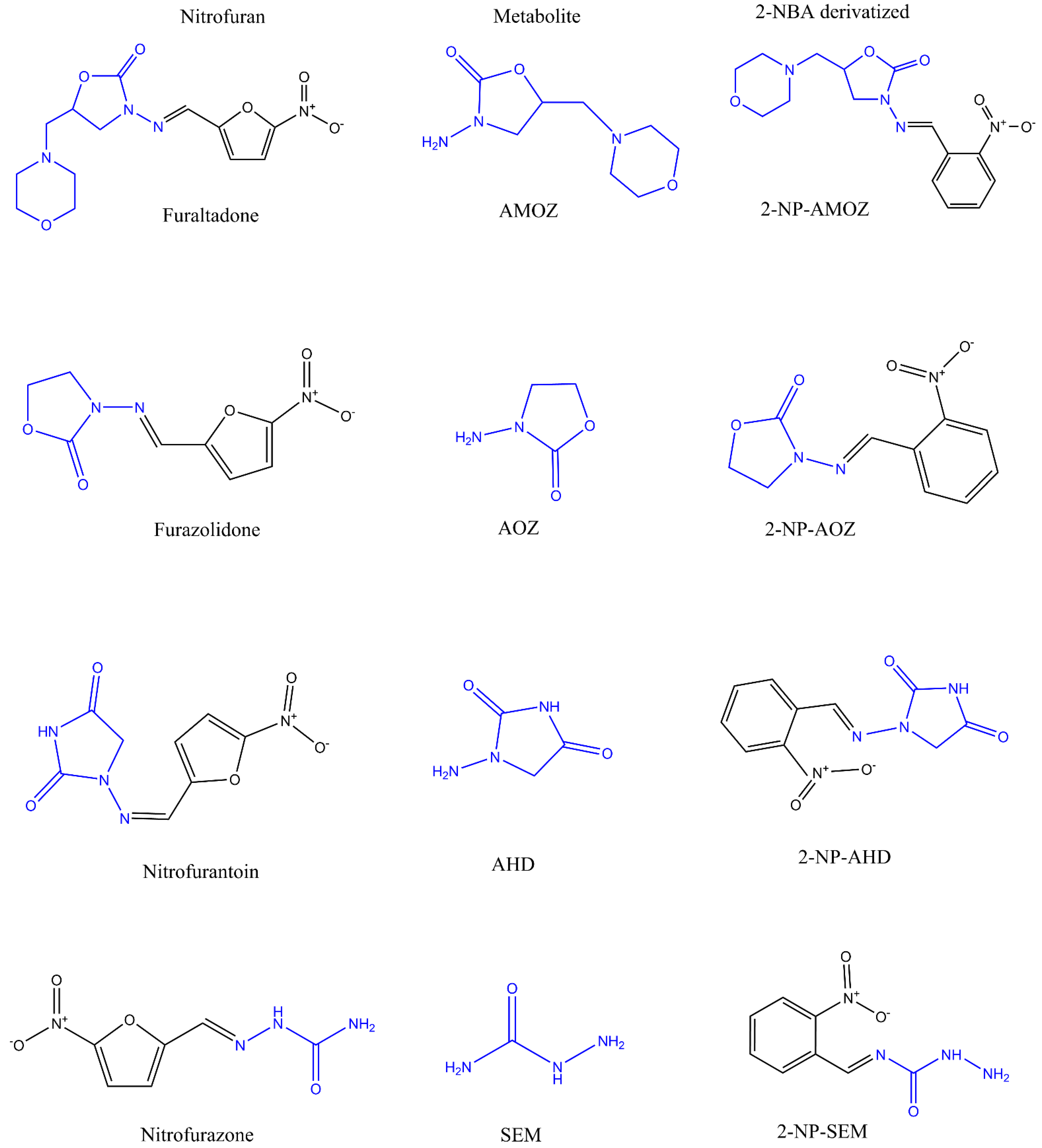
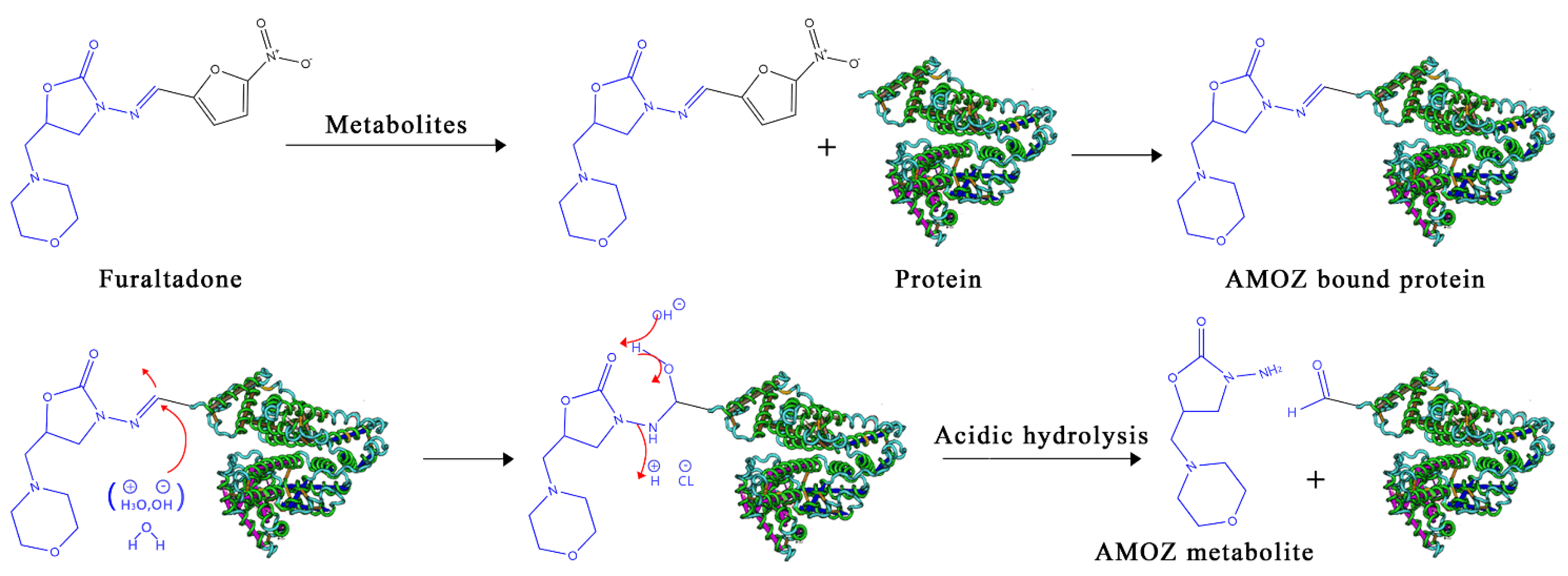
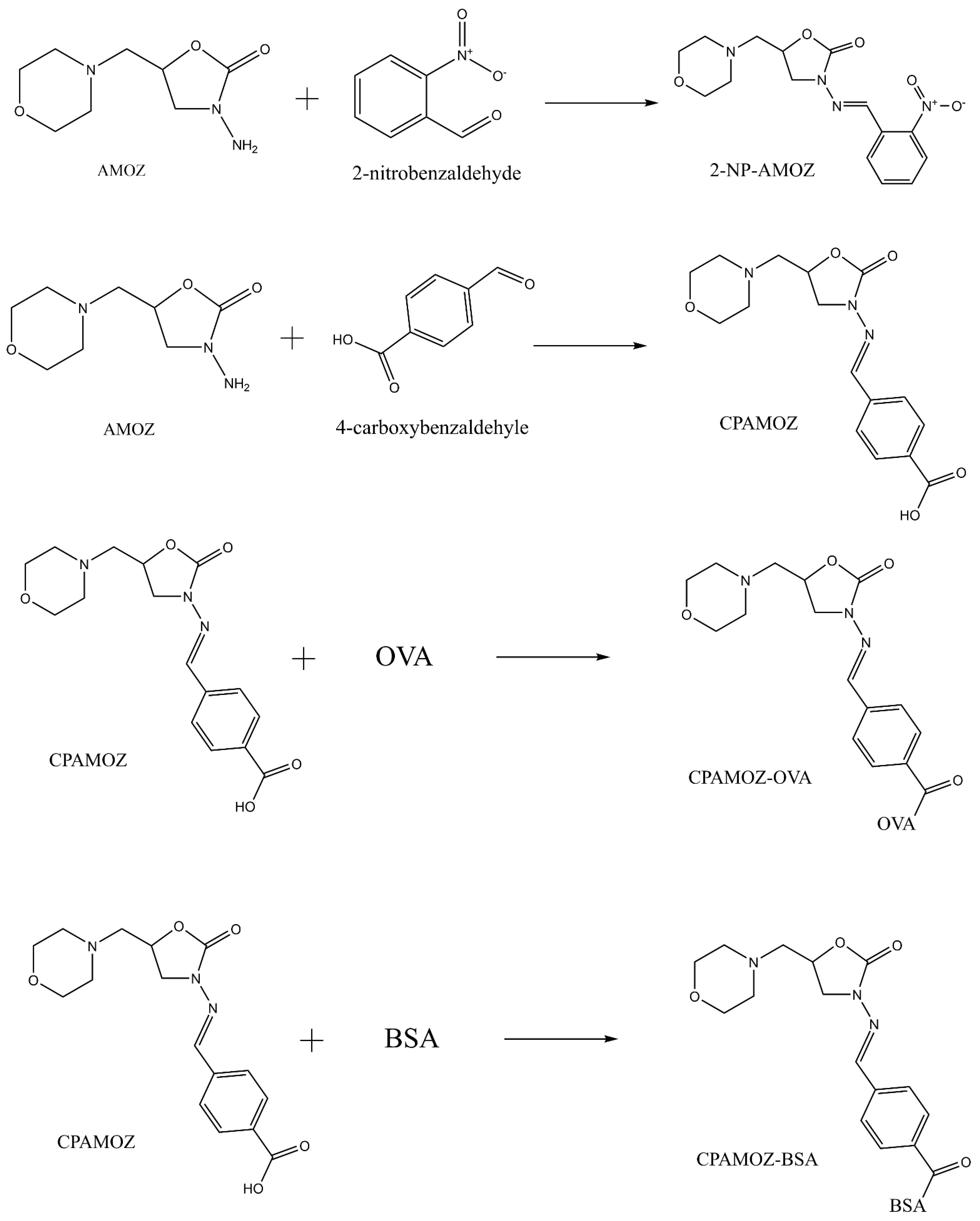
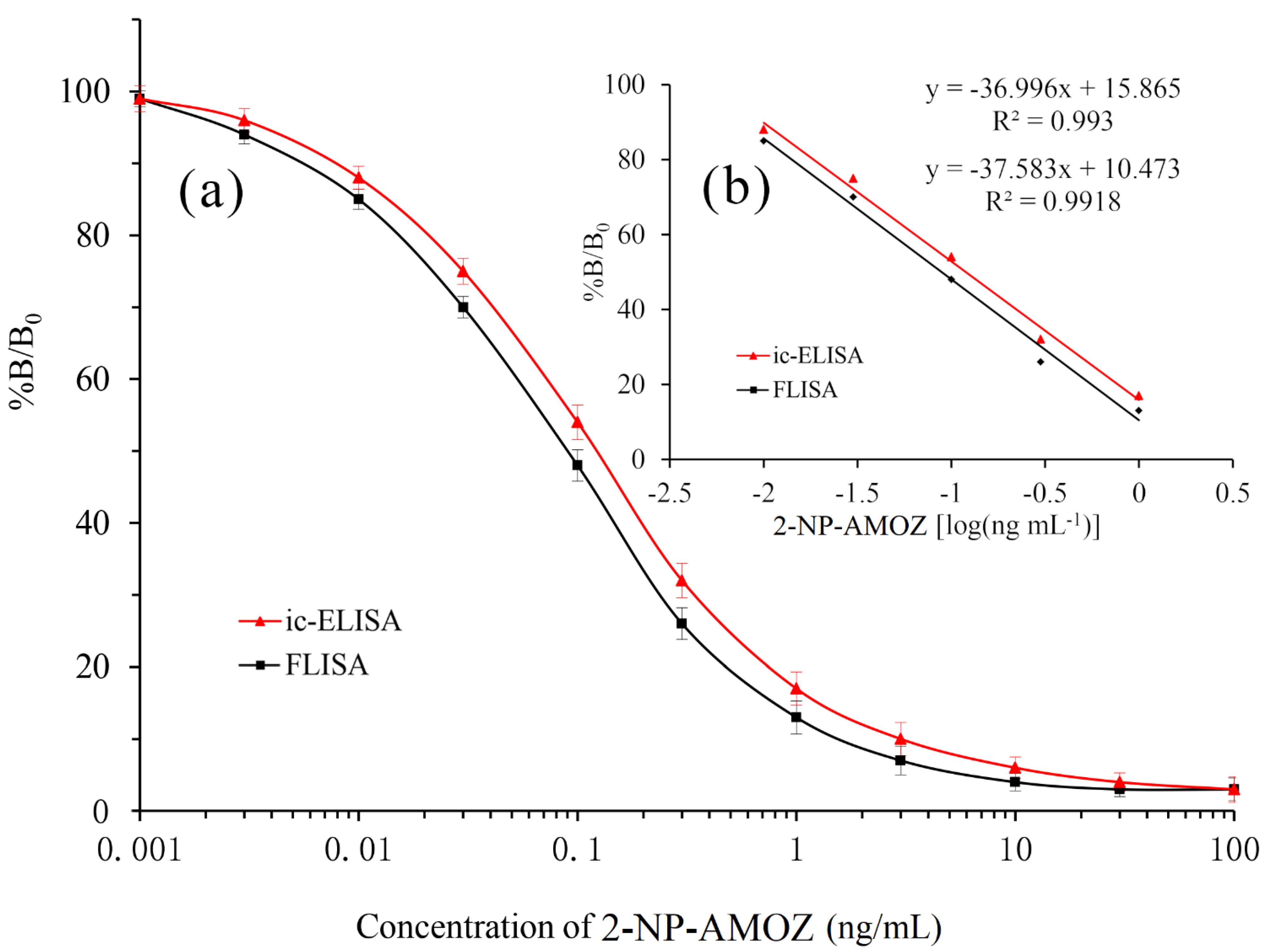
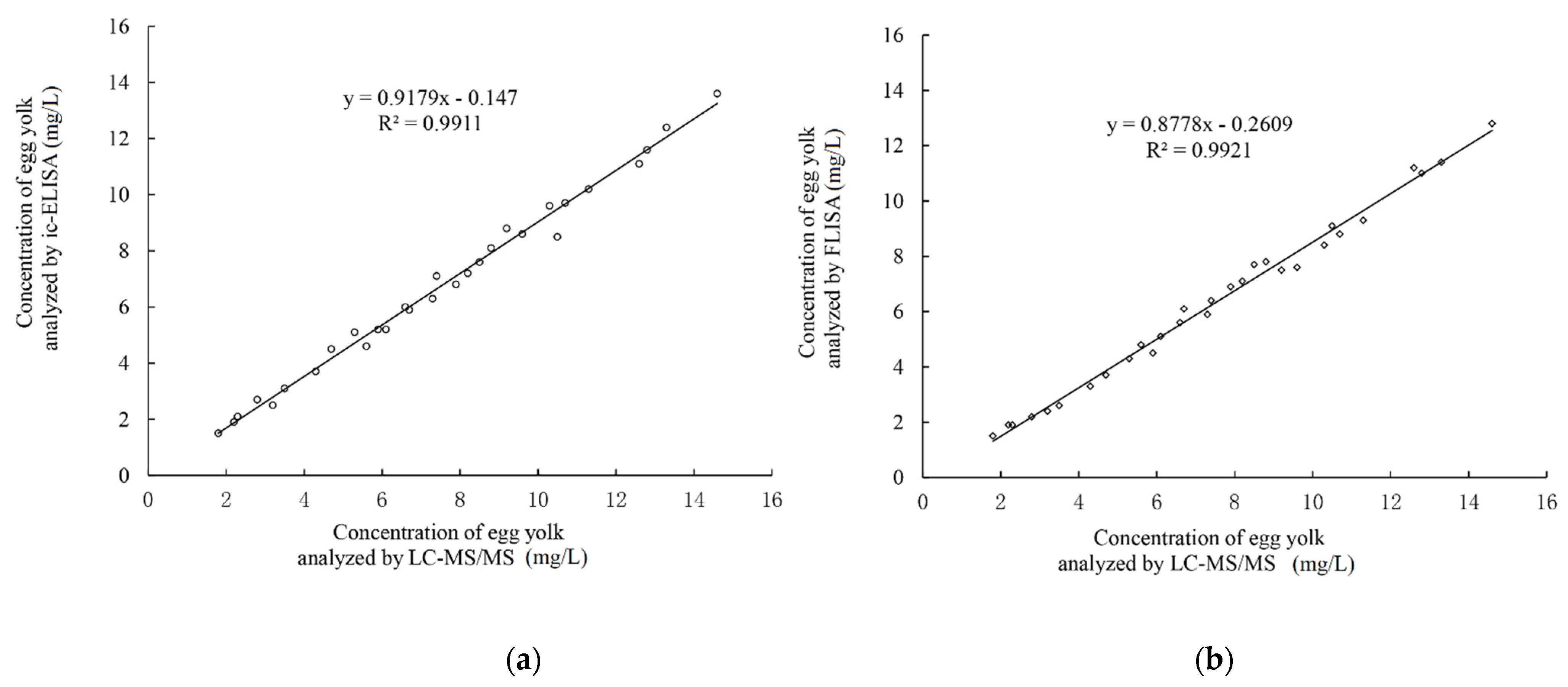
| Compounds | IC50 (ng/mL) | Cross-Reactivity (%) |
|---|---|---|
| 2-NP-AMOZ | 0.11 | 100 |
| CPAMOZ | 0.09 | 122.2 |
| AMOZ | 1.03 | 10.7 |
| Furaltadone | 1.24 | 8.9 |
| Furazolidone | >1000 | <0.01 |
| AOZ | >1000 | <0.01 |
| 2-NP-AOZ | >1000 | <0.01 |
| Nitrofurantoin | >1000 | <0.01 |
| AHD | >1000 | <0.01 |
| 2-NP-AHD | >1000 | <0.01 |
| Nitrofurazone | >1000 | <0.01 |
| SEM | >1000 | <0.01 |
| 2-NP-SEM | >1000 | <0.01 |
| 2-NBA | >1000 | <0.01 |
| 4-CBA | >1000 | <0.01 |
| Sample | Spiked (μg/kg) | Ic-ELISA | FLISA | The Correlations (R2) | ||
|---|---|---|---|---|---|---|
| Recovery ± SD (%, n = 15) | CV (%, n = 15) | Recovery ± SD (%, n = 15) | CV (%, n = 15) | |||
| Catfish | 0.5 | 89.2 ± 8.4 | 9.5 | 92.6 ± 7.1 | 7.6 | 0.9652 |
| 1.0 | 81.6 ± 6.3 | 7.7 | 85.7 ± 6.1 | 7.2 | ||
| 5.0 | 90.3 ± 8.0 | 8.8 | 92.1 ± 7.1 | 7.7 | ||
| Sturgeon | 0.5 | 88.8 ± 7.4 | 8.4 | 91.8 ± 6.5 | 7.1 | 0.9758 |
| 1.0 | 87.4 ± 8.3 | 9.5 | 90.0 ± 8.1 | 9.0 | ||
| 5.0 | 105.3 ± 10.2 | 9.7 | 103.6 ± 6.1 | 5.9 | ||
| Shrimp | 0.5 | 87.8 ± 8.1 | 9.2 | 91.0 ± 7.8 | 8.6 | 0.9856 |
| 1.0 | 81.1 ± 6.5 | 8.0 | 84.4 ± 6.5 | 7.7 | ||
| 5.0 | 82.4 ± 7.9 | 9.6 | 86.2 ± 6.5 | 7.6 | ||
| Crab | 0.5 | 101.9± 7.6 | 7.5 | 104.1 ± 7.0 | 6.7 | 0.9927 |
| 1.0 | 84.4 ± 6.1 | 7.2 | 87.4 ± 6.9 | 7.8 | ||
| 5.0 | 86.4 ±4.8 | 5.6 | 81.4 ± 5.9 | 7.2 | ||
| Swine muscle | 0.5 | 88.9 ± 7.6 | 8.5 | 92.1 ± 7.5 | 8.1 | 0.9861 |
| 1.0 | 95.4 ± 6.3 | 6.6 | 97.4 ± 6.0 | 6.1 | ||
| 5.0 | 85.9 ± 8.1 | 9.4 | 87.9 ± 8.7 | 9.8 | ||
| Swine liver | 0.5 | 88.0 ± 5.5 | 6.3 | 91.1 ± 5.6 | 6.1 | 0.9835 |
| 1.0 | 90.3 ± 7.9 | 8.8 | 93.1 ± 9.0 | 9.6 | ||
| 5.0 | 81.7 ± 5.9 | 7.2 | 83.9 ± 4.6 | 5.5 | ||
| Chicken muscle | 0.5 | 91.9 ± 5.1 | 5.5 | 94.2 ± 4.6 | 4.9 | 0.9733 |
| 1.0 | 83.2 ± 5.9 | 7.1 | 88.2 ± 6.0 | 6.9 | ||
| 5.0 | 83.6 ± 4.7 | 5.6 | 87.3 ± 4.1 | 4.7 | ||
| Chicken liver | 0.5 | 85.1 ± 7.1 | 8.4 | 87.6 ± 7.4 | 8.5 | 0.9765 |
| 1.0 | 89.8 ± 6.7 | 7.4 | 92.3 ± 7.1 | 7.7 | ||
| 5.0 | 87.9± 4.7 | 5.4 | 91.1 ± 4.3 | 4.8 | ||
Publisher’s Note: MDPI stays neutral with regard to jurisdictional claims in published maps and institutional affiliations. |
© 2021 by the authors. Licensee MDPI, Basel, Switzerland. This article is an open access article distributed under the terms and conditions of the Creative Commons Attribution (CC BY) license (https://creativecommons.org/licenses/by/4.0/).
Share and Cite
Xie, Y.; Wang, Y.; Yan, X.; Gan, L.; Le, T. Preparation of Monoclonal Antibody and Development of Indirect Competitive Enzyme-Linked Immunosorbent Assay and Fluorescence-Linked Immunosorbent Assay for Detecting 3-Amino-5-methylmorpholino-2-oxazolidinone (AMOZ) in Edible Animal Tissue. Molecules 2021, 26, 4243. https://doi.org/10.3390/molecules26144243
Xie Y, Wang Y, Yan X, Gan L, Le T. Preparation of Monoclonal Antibody and Development of Indirect Competitive Enzyme-Linked Immunosorbent Assay and Fluorescence-Linked Immunosorbent Assay for Detecting 3-Amino-5-methylmorpholino-2-oxazolidinone (AMOZ) in Edible Animal Tissue. Molecules. 2021; 26(14):4243. https://doi.org/10.3390/molecules26144243
Chicago/Turabian StyleXie, Yong, Yarong Wang, Xueling Yan, Lu Gan, and Tao Le. 2021. "Preparation of Monoclonal Antibody and Development of Indirect Competitive Enzyme-Linked Immunosorbent Assay and Fluorescence-Linked Immunosorbent Assay for Detecting 3-Amino-5-methylmorpholino-2-oxazolidinone (AMOZ) in Edible Animal Tissue" Molecules 26, no. 14: 4243. https://doi.org/10.3390/molecules26144243
APA StyleXie, Y., Wang, Y., Yan, X., Gan, L., & Le, T. (2021). Preparation of Monoclonal Antibody and Development of Indirect Competitive Enzyme-Linked Immunosorbent Assay and Fluorescence-Linked Immunosorbent Assay for Detecting 3-Amino-5-methylmorpholino-2-oxazolidinone (AMOZ) in Edible Animal Tissue. Molecules, 26(14), 4243. https://doi.org/10.3390/molecules26144243







